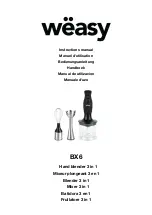
for recipes calling for less than 3-1/2
cups (875 ml) (496 g) of fl our, such as
pizza dough.
Nub of dough forms on top of blade and
does not become uniformly kneaded:
Stop machine, carefully remove dough,
divide into 3 pieces and redistribute evenly
in work bowl. Continue processing until
dough is uniformly soft and pliable.
Dough feels tough after kneading:
Divide dough into 2 or 3 pieces and redis-
tribute evenly in bowl. Process 10 seconds
or until uniformly soft and pliable.
Soft dough or liquid leaks onto base of
food processor:
Always start processor before adding liquid
and add liquid only as fast as dry ingredi-
ents absorb it.
Motor stops:
• Cover may have become unlocked.
• Power cord may have become un-
plugged.
• Excessive strain may have caused motor
to overheat and stop. Wait for the motor
to cool, 5-10 minutes. A safety protector
in the motor prevents excessive over-
heating. If the motor stops, turn machine
off. After 5-10 minutes, divide dough
into 2 batches and complete processing.
Pinch dough to make sure that it is not
too stiff to knead comfortably by hand.
If it is, add liquid, 1 teaspoon (5 ml) at a
time, until dough is suffi ciently moist to
clean inside of bowl.
Dough doesn’t rise:
We recommend you always test activity of
yeast before using, by stirring it and add-
ing at least 1/2 teaspoon (2 ml) sugar into
about 1/3 cup (75 ml) warm liquid (105-
120°F) (40-48°C). Within 10 minutes foam
should develop, indicating yeast is active.
Do not use dry yeast after expiration date
on package.
Do not use warmer water, or overheat
dough with excessive kneading, as it may
kill the yeast cells. All other liquid should
be cold.
Don’t knead so long that dough becomes
overheated. The ideal temperature for
kneaded dough is 80°F (26°C); it should
never exceed 100°F (37°C).
Let dough rise in draft-free environment of
about 80-90°F (26-32°C).
Dough containing whole grain fl our will
take longer to rise than dough made of
white fl our only.
Baked bread is too heavy:
Next time, feel dough to be sure it is
uniformly soft, pliable and slightly sticky
before setting aside to rise. Let dough
fully double in bulk in bowl or bag, punch
it down, then let it double again after it is
shaped.
PROBLEMS AND
SOLUTIONS WITH
TYPICAL SWEET DOUGHS
Motor slows down:
• Amount of dough may exceed maximum
capacity. Remove half, and process in 2
batches.
• Don’t process too long after all ingre-
dients are incorporated. Rich doughs
will give you good results after only 30
seconds of kneading.
Blade doesn’t incorporate ingredients:
Butter or margarine, if not melted, must
be cut into tablespoon-size pieces before
being added to work bowl.
Dough blade rises in work bowl:
Blade may not have been pushed down as
far as possible before processing started.
Machine may be overloaded. Remove half
of dough and process in 2 batches.
Motor stops:
See comments under ‘Typical Bread
Dough’ Problems and Solutions
Dough doesn’t rise:
See comments under ‘Typical Bread
Dough’ Problems and Solutions
CLEANING AND
STORAGE
Keep your Food Processor ready to use on
a kitchen counter. When not in use, leave it
17
















































